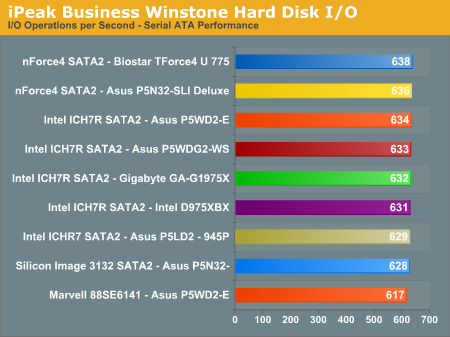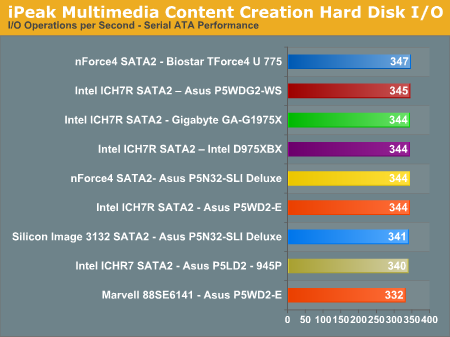NVIDIA nForce4 Ultra: Biostar's Performance Surprise
by Gary Key on February 16, 2006 12:05 AM EST- Posted in
- Motherboards
Disk Controller Performance
With the variety of disk drive benchmarks available, we needed a means of comparing the true performance of the wide selection of controllers. The logical choice was Anand's storage benchmark first described in Q2 2004 Desktop Hard Drive Comparison: WD Raptor vs. the World. The iPeak test was designed to measure "pure" hard disk performance, and in this case, we kept the hard drive as consistent as possible while varying the hard drive controller. The idea is to measure the performance of a hard drive controller with a consistent hard drive.
We played back Anand's raw files that recorded I/O operations when running a real world benchmark - the entire Winstone 2004 suite. Intel's iPEAK utility was then used to play back the trace file of all IO operations that took place during a single run of Business Winstone 2004 and MCC Winstone 2004. To try to isolate performance differences to the controllers that we were testing, we used the Maxtor MaXLine III 7L300S0 300GB 7200 RPM SATA drive in all tests . The drive was formatted before each test run and a composite average of 5 tests on each controller interface was tabulated in order to ensure consistency in the benchmark.
iPeak gives a mean service time in milliseconds; in other words, the average time that each drive took to fulfill each IO operation. In order to make the data more understandable, we report the scores as an average number of IO operations per second so that higher scores translate into better performance. This number is meaningless as far as hard disk performance is concerned, as it is just the number of IO operations completed in a second. However, the scores are useful for comparing "pure" performance of the storage controllers in this case.
With the variety of disk drive benchmarks available, we needed a means of comparing the true performance of the wide selection of controllers. The logical choice was Anand's storage benchmark first described in Q2 2004 Desktop Hard Drive Comparison: WD Raptor vs. the World. The iPeak test was designed to measure "pure" hard disk performance, and in this case, we kept the hard drive as consistent as possible while varying the hard drive controller. The idea is to measure the performance of a hard drive controller with a consistent hard drive.
We played back Anand's raw files that recorded I/O operations when running a real world benchmark - the entire Winstone 2004 suite. Intel's iPEAK utility was then used to play back the trace file of all IO operations that took place during a single run of Business Winstone 2004 and MCC Winstone 2004. To try to isolate performance differences to the controllers that we were testing, we used the Maxtor MaXLine III 7L300S0 300GB 7200 RPM SATA drive in all tests . The drive was formatted before each test run and a composite average of 5 tests on each controller interface was tabulated in order to ensure consistency in the benchmark.
iPeak gives a mean service time in milliseconds; in other words, the average time that each drive took to fulfill each IO operation. In order to make the data more understandable, we report the scores as an average number of IO operations per second so that higher scores translate into better performance. This number is meaningless as far as hard disk performance is concerned, as it is just the number of IO operations completed in a second. However, the scores are useful for comparing "pure" performance of the storage controllers in this case.












31 Comments
View All Comments
Zoomer - Monday, September 18, 2006 - link
I was really interested in buying this board to replace a dead board until I read the part about ALC 850. Urgh.The 10/100 ethernet was also an issue, but I could have lived with that. But no HD Audio? This is 2006, not 1996.
neweggster - Wednesday, February 22, 2006 - link
I would like to see more articles from Biostar. They seem to have a good idea on what performance is. Any idea if you guys could get a article on the Biostar TForce4U Socket 939 NVIDIA nForce4 Ultra AMD mobo?Gary Key - Wednesday, February 22, 2006 - link
We are working on it. :)cpeter38 - Tuesday, February 21, 2006 - link
How come AT has taken down the RS580 article (at least) twice now??Gary Key - Tuesday, February 21, 2006 - link
The NDA for the RD580 is on 3/2/06. ATI has requested the review sites adhere to this date. However, if you look around the net the article has been saved in a zip file and is available for viewing. ;-)
cpeter38 - Tuesday, February 21, 2006 - link
THANK YOU!!!!(for the explanation)
cpeter38 - Tuesday, February 21, 2006 - link
ACCCHHH!!********** EDIT *************** EDIT ************
RD580!!!
ronein - Sunday, February 19, 2006 - link
I second that!
lexmark - Friday, February 17, 2006 - link
Very detailed and coherent article! I am in no way in the market for an intel/biostar board (how many are? ;), but the review was a pleasure to read. I found the author's writing style to be very unique and the article overall was outstanding. Keep up the good work AT!bldckstark - Thursday, February 16, 2006 - link
Good job on including the min and max frame rates on the graphs. That is an excellent addition. Now if we can just get the median and mode......... *>}